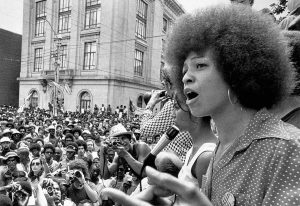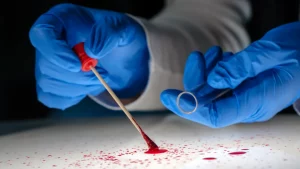When you see someone in danger, do you react? Do you stand there and watch? Or do you step in and intervene? It’s a hard decision, especially when you analyze the situation. On March 13th, 1964, some individuals made that choice. Their choices would later haunt them. Winston Moseley murdered and assaulted Kitty Genovese in the middle of the street, and no one did a thing. Why? Whose fault was it? Are they to blame too?

Kitty Genovese was twenty-eight years old and the manager of a local bar. The small apartment on Austin Street she shared with her girlfriend was home. The area where she lived wasn’t terrible. There were a couple of noisy bars on the street but usually, no one paid much attention. This was a normal neighborhood, where everyone knew each other.1 Her neighbors were friendly and crime was low. Of course, Kitty loved the city. Her Italian-American parents left New York due to urban crime, but Kitty refused. Kew Gardens, Queens was safe.2 Regardless of where she was, Kitty was the type of person everyone liked. Angelo Lanzone, one of her friends, would later say, “Kitty was attractive but there was more to her than looks, Kitty had charm.”3 She was friends with everyone, even with that odd neighbor, Karl Ross. He was quite strange, a bit quiet, but Kitty didn’t care. Kitty was nice to everyone. She had a friendly face. That’s what made her a great employee, and what was launching her career forward. She planned on opening her own Italian restaurant. 4 Kitty stood out from the crowd. Her charisma and kindness made her approachable. Nobody could miss her.

Winston Moseley worked as a machine operator in a town north of the Bronx. He was only twenty-nine years old but had already married twice. His childhood was rough after his mother walked out on him and his father, but life continued. His second wife Betty sometimes worried about his moods, but they had a normal marriage. Still, he was bitter, and he was angry. He felt that he had to work twice as hard as other workers, and Moseley didn’t feel as though he was someone’s equal. At times, he felt like he wasn’t standing out enough.5
At three in the morning, on March 13th, 1964, Kitty left her job and drove home. She parked and exited her car, like usual. As she got out, she noticed a figure near her. Kitty ran because she was near her apartment and close to safety. Later, when speaking to the court, Winston Moseley detailed the events of that night, “As she got out of the car, she saw me and ran. I ran after her and had a knife in my hand. I could run much faster than she could, and I jumped on her back and stabbed her several times.”6

When he struck, Kitty immediately cried out, as anyone would. She was loud enough to wake neighbors. “Oh my god, he stabbed me! Please help me!” she yelled. 7 At that moment, someone did react. Robert Mozer opened his window and shouted, “Leave that girl alone!”8 Moseley looked up at him, shrugged, and then he left. Although Mozer acted and managed to scare Moseley off, that was all that occurred. Kitty dragged herself into the nearest apartment in an attempt to find safety. She managed to make it to the back of the building to the door of her friend Karl Ross.
Moseley stayed in his car and waited until he realized no one would interfere any further. Then he returned to find Kitty. In his trial, he explained his reason for returning, “I’d not finished what I set out to do.”9
Karl Ross opened the door and saw Moseley on top of Kitty, but he closed the door. Ross had been drinking and was afraid. He believed that the attacker would harm him next, and he wasn’t willing to call the police out of fear. Ross assumed the questions would turn on him and his high level of alcohol. When he was under questioning, he said, “I didn’t want to get involved.”10 After he saw Kitty’s attack, he phoned another neighbor. Then he climbed out of his window and headed to another apartment. There, Ross called the police.11

Kitty Genovese’s story has resurfaced countless times, largely because of the significant number of witnesses. The New York Times reported a headline the day after the event that read, “37 Who Saw Murder Didn’t Call the Police.”12 Yet, the amount of witnesses varies from the police report. The report only listed six witnesses. There was outrage amongst the public. How could there be no interference from bystanders?13 Regardless of the misinformation; the facts remained. Kitty Genovese died, and no one provided immediate help or stepped in. In the end, the real question was, why did nobody help?

Altruism refers to unselfishness when it comes to the wellbeing of others. Social psychologists have analyzed the idea of an altruistic paradox. This is the way some people will perform self-sacrificial acts to benefit others. It’s a paradox because it’s a contradiction of survival of the fittest. This changes the narrative of selfish humans.14Were Kitty’s neighbor’s lacking altruism?
The bystander effect arose from Kitty Genovese’s attack. When in a large setting with many people, the chances of someone taking action in an event decreases. The chances of single individuals offering help when alone are a lot higher than in groups. This is due to the diffusion of responsibility between people. Without realizing it, individuals rely on other people in a group. The mentality of “they will do something” seems to settle among the crowd. Individuals look to each other to act first. Also, situational forces can sometimes overpower individuals’ personal beliefs. At times, a situation may affect someone’s behavior, even though the drive to act is there. An individual may feel overpowered by an event, and not react the way they would expect. Still, studies show that one person’s action could lead to a whole group reacting. 15 Many people heard Kitty scream, but they believed they were people arguing. Some even reported they believed someone else must have already called the police.16
Police arrested Winston Moseley five days after the attack. He confessed to the sexual assault and murder of Kitty Genovese. Moseley also admitted to the murders of Barbara Kralik and Anna Mae Johnson. They were also young women, who Moseley claimed to have been “compelled to kill.”17 His trial occurred on June 8th, 1964. He received the death sentence but later received a life sentence, due to a plead of insanity. All his parole hearings were not approved. Moseley died at 81 years old on March 28th, 2016, as the oldest inmate in his prison.18
Kitty Genovese’s attack lasted around 33 minutes. It occurred between 3:19 and 3:52 AM. To her, it probably would have felt an eternity.19 The retelling of her story still continues and her name lives on, although she didn’t. Kitty’s murder is in many places, textbooks, documentaries, and more. It’s become a myth, rather than the life of a young woman, who had begun to live. Kitty Genovese would have celebrated her 84th birthday in 2019.
It’s after midnight; the sun hasn’t risen yet. You’re in bed, already asleep. You hear a scream, someone is begging for help. You wake and look outside your window. A man is stabbing a woman, right below your apartment window. You’re scared, he’s armed. Has someone else already called the police? Someone else will go help her. Do you go anyways? It might not be so easy. Or is it? How do you know? What would you do?
- A.M. Rosenthal, Thirty-Eight Witnesses: The Kitty Genovese Case (New York: McGraw-Hill, 1964), 22. ↵
- Kevin Cook, Kitty Genovese : the murder, the bystanders, the crime that changed America (New York: W. W. Norton & Company, 2014), 27-30. ↵
- Kevin Cook, Kitty Genovese : the murder, the bystanders, the crime that changed America (New York: W. W. Norton & Company, 2014), 7. ↵
- Kevin Cook, Kitty Genovese : the murder, the bystanders, the crime that changed America (New York: W. W. Norton & Company, 2014), 56. ↵
- Kevin Cook, Kitty Genovese : the murder, the bystanders, the crime that changed America (New York: W. W. Norton & Company, 2014), 74. ↵
- Percy Smith, “Silent witness,” Safety & Health Practitioner 30, no. 5 (2012): 43. ↵
- A.M. Rosenthal, Thirty-Eight Witnesses: The Kitty Genovese Case (New York: McGraw-Hill, 1964), 23. ↵
- A.M. Rosenthal, Thirty-Eight Witnesses: The Kitty Genovese Case (New York: McGraw-Hill, 1964), 23. ↵
- Saul M. Kassin, “The Killing of Kitty Genovese: What Else Does This Case Tell Us?,” Perspectives on Psychological Science 12, no. 3 (2017): 375. ↵
- Kevin Cook, Kitty Genovese: the murder, the bystanders, the crime that changed America (New York: W. W. Norton & Company, 2014), 109. ↵
- Kevin Cook, Kitty Genovese: the murder, the bystanders, the crime that changed America (New York: W. W. Norton & Company, 2014), 112. ↵
- Arthur J. Lurigio, “Crime Narratives, Dramatizations, and the Legacy of the Kitty Genovese Murder: A Half Century of Half Truths,” Criminal Justice and Behavior 42, no. 7 (July 2015): 783. ↵
- Salem Press Encyclopedia, 2018, s.v. “Kitty Genovese Dies as Her Cries for Help Are Ignored,” by Leigh Husband Kimmel. ↵
- Salem Press Encyclopedia, 2018, s.v. “Altruism, cooperation, and empathy,” by Jim Fultz and Elizabeth Schafer. ↵
- Salem Press Encyclopedia, 2018, s.v. “Bystander intervention and social psychology,” by Steve Nida. ↵
- Salem Press Encyclopedia, 2018, s.v. “Kitty Genovese Dies as Her Cries for Help Are Ignored,” by Leigh Husband Kimmel. ↵
- Marcia M. Gallo, “The Parable of Kitty Genovese, the New York Times, and the Erasure of Lesbianism,” Journal of the History of Sexuality 23, no. 2 (2014): 283. ↵
- Salem Press Encyclopedia, 2018, s.v. “Kitty Genovese Dies as Her Cries for Help Are Ignored,” by Leigh Husband Kimmel. ↵
- Kevin Cook, Kitty Genovese : the murder, the bystanders, the crime that changed America (New York: W. W. Norton & Company, 2014), 3-4. ↵




75 comments
Shecid Sanchez
I have never heard about the Kitty Genovese case before but it was such a sad case. this case really showed the Fight or Flight response in people. It’s crazy how she had it away from form and went to where she believed was safe, but no one did anything because they thought if they got involved he would kill them too. People assuming that other people called the police while Kitty literally screamed that he stabbed her is insane to me. If people would have helped her and reacted differently maybe kitty would have made it out alive. This article made me wonder what I would’ve done in that situation and as much as I would love to say I would’ve put my life at risk to help her who knows how I would actually react in that type of scenario.
Makayla Soto
Seeing cases like these is honestly so sad and upsetting. These types of things still happen to woman and no change has been done. Someone innocent lost their life while others watched it happen. How is that fair? Ross allowed it to happen and did something after the fact she had got attacked. It just such a sickening case and the fact it still happens in today’s world is even worse.
Guadalupe Altamira
This article really did catch my eye with the questions at the beginning and the detailed scenario at the end. It’s terrible what happened to Kitty that night and the fact that no one helped at all made my blood boil. It’s somewhat understandable to not want to get involved but come on now, she was at the door of Karl Ross hoping he would help her. This article can really make you feel the emotions going on and the skills behind it show intensely.
Daniela Iniguez-Jaco
This was very well-written and gave me chills! Such a tragedy that occurred to Kitty, she deserves justice for what happened to her, if only people were kind to her in her last moments of life like she was kind to everyone else. If I was a bystander I do not care if I risk my life, I would have attempted to help her in any way and immediately call the police as soon as I heard a scream. All of the people that watched and did not do anything to help her should get into legal trouble because they let a murder happen when they could’ve gotten her the help she needed at that moment.
Jadyn Evans
This is such a tragic story. I could never imagine that someone who is in desperate need of help is not offered it by her neighbors and even friends. I understand it was out of fear but if they stepped up fast enough maybe she would still have been alive. Other than that the article is very well written and i appreciate their writing skills and insight in bringing to light such a tragic story with a lesson for all within itself.
Edward Cerna
This is such a heartbreaking story. Everytime you read of such an untimely death it really upsets anyone. It is so frustrating that she could have had help but people simply assumed somebody else would help. I have never heard of this story before and I am glad to have learned about it although it made my heart heavy. I like how the article began with including the reading and asking what they would do? Overall, this was a great article!
Sara Alvirde
The story of Kitty Genovese is heartbreaking and a story that could’ve been saved if the bystanders were faster enough to react by calling the police or at least maybe throw something at the man hurting her. I have heard of stories like this before where no one is willing to check on noise complaints or in this case when it happening right in front of them don’t bother to be of any help. It is one thing to be shocked and afraid of the murderer but also an option to run and cry for help.
Evangelina Villegas
This article was really good and I liked how you described the kind of character Kitty Genovese was before the fatal encounter with Winston Moseley. What happened to her was truly tragic and something that no person, especially someone so young, should have to face. The part that made me both sad and angry was the fact that there were people in the building that could’ve helped her during the first attack, even before the second attack happened, but no one really came to help. What makes it worse is that the bystander effect still occurs today because when something is happening everyone who witnesses it will always think “oh maybe someone else will help that person”, but in reality nobody actually does anything.
Desiree Arizmendez
In psychology, we learned about Kitty Genovese because of the bystander effect. It really is such a tragic story. The article is very well written, clear to understand. It is very crazy how this woman was crying out for help and no one was stepping up to help. The author did an incredible job explaining the bystander effect and the way the ending tied in the whole article was really amazing.
Kimberly Rubio
It is interesting reading this article right after reading about the Central Park Five. Because these innocent men were on my mind, I can understand where Ross was coming from. What if he called the police and, because of his drunkenness, he was accused of the murder? After all, police would have found her dead, outside his door. I wonder if my view would have been different if I hadn’t just read the article about the Central Park Five? I would like to think I would be a person to intervene in a situation like this, but I do sympathize with Ross. It is very sad that at least six individuals heard/saw Kitty’s attack and did nothing. If they had, maybe she would have lived.